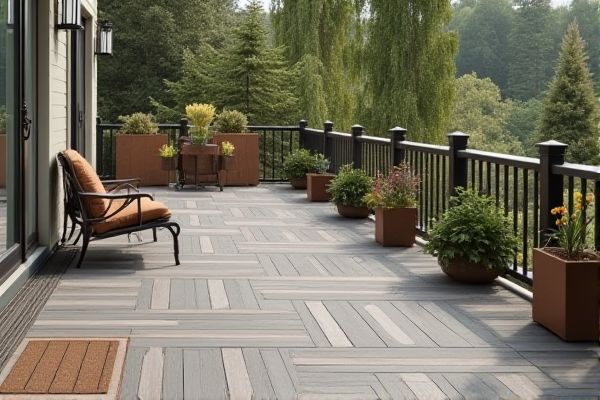
Peel-and-stick tiles offer quick installation and a smooth surface ideal for indoor spaces, while interlocking deck tiles provide durability and weather resistance suited for outdoor decks. Explore the article to determine which option best fits Your space and lifestyle needs.
Table of Comparison
| Feature | Peel-and-Stick Tile | Interlocking Deck Tiles |
|---|---|---|
| Installation | Simple peel-and-stick; no tools required | Snap together interlocking design; requires minimal tools |
| Material | Vinyl or PVC with adhesive backing | Wood, composite, or plastic panels |
| Durability | Suitable for indoor, less durable outdoors | Designed for outdoor use; weather-resistant |
| Maintenance | Easy to clean; replace individual tiles if damaged | Requires routine cleaning; replace tiles as needed |
| Surface Compatibility | Best on smooth, clean surfaces | Works on flat or slightly uneven outdoor surfaces |
| Cost | Generally more affordable per tile | Higher initial cost due to durable materials |
| Applications | Indoor walls, backsplashes, and flooring accents | Outdoor patios, balconies, rooftops, and decks |
| Longevity | 2-5 years depending on environment | 5-15 years with proper care |
Introduction to Peel-and-Stick Tiles and Interlocking Deck Tiles
Peel-and-stick tiles offer a simple, adhesive-backed solution ideal for quick interior updates on floors and walls, providing water-resistant and easy-to-clean surfaces available in various designs. Interlocking deck tiles are designed for outdoor use, featuring durable materials like wood, composite, or plastic, with snap-together edges ensuring stability on patios, balconies, or rooftops. Your choice depends on whether you need a versatile, indoor aesthetic enhancement or a robust, weather-resistant deck covering.
Key Differences Between Peel-and-Stick and Interlocking Deck Tiles
Peel-and-stick tiles offer a simple installation process with adhesive backing, making them ideal for smooth indoor surfaces, while interlocking deck tiles provide a sturdy, modular design perfect for outdoor spaces and uneven surfaces. The durability and water resistance of interlocking tiles surpass that of peel-and-stick options, which may peel over time or in high-moisture areas. Understanding these key differences ensures you select the best tile type to suit your specific flooring needs and environment.
Material Composition: What Are They Made Of?
Peel-and-stick tiles are typically composed of vinyl or laminate materials with an adhesive backing for easy installation on smooth surfaces. Interlocking deck tiles are often made from wood, composite, or plastic materials designed for outdoor durability and feature connector systems that snap together without adhesives. The choice between these materials affects suitability for indoor versus outdoor use, maintenance requirements, and overall longevity.
Installation Process: Ease and Tools Required
Peel-and-stick tiles offer a straightforward installation process requiring no special tools, simply involving the removal of a backing paper and pressing tiles onto a clean, smooth surface. Interlocking deck tiles need more time for assembly as each tile locks into adjacent ones using built-in connectors, often requiring a rubber mallet or similar tool to ensure tight seams. Both options are suitable for DIY projects, but peel-and-stick tiles excel in speed while interlocking deck tiles provide durability and precise alignment.
Durability and Weather Resistance Comparison
Peel-and-stick tiles typically offer moderate durability, suitable for indoor or low-traffic areas, but they may degrade under prolonged exposure to moisture and extreme weather. Interlocking deck tiles are designed with robust materials like composite wood or plastic, providing superior weather resistance and the ability to withstand heavy foot traffic and harsh outdoor elements. Choosing interlocking deck tiles ensures your outdoor space remains durable and visually appealing despite exposure to rain, sun, and temperature fluctuations.
Design and Style Options for Each Tile Type
Peel-and-stick tiles offer a wide variety of design options including intricate patterns, faux wood, stone, and ceramic looks ideal for quick DIY updates on walls and floors. Interlocking deck tiles focus on natural materials like hardwood, bamboo, and composite, providing a textured, rustic aesthetic perfect for outdoor patios and terraces. Both tile types cater to diverse styles but peel-and-stick tiles excel in detailed prints while interlocking deck tiles emphasize durability and natural beauty.
Maintenance and Cleaning Requirements
Peel-and-stick tiles require minimal maintenance, as their smooth surface resists stains and can be easily wiped clean with a damp cloth. Interlocking deck tiles often need more attention, especially if made from wood, requiring periodic cleaning and sealing to prevent dirt buildup and weather damage. Both options benefit from regular inspection to maintain their appearance and longevity, but peel-and-stick tiles offer a more straightforward cleaning routine.
Cost Analysis: Initial Investment and Long-Term Value
Peel-and-stick tiles typically offer a lower initial investment, ranging from $1 to $5 per square foot, making them budget-friendly for quick, DIY projects. Interlocking deck tiles, priced between $10 and $15 per square foot, demand a higher upfront cost but provide superior durability and weather resistance. Long-term value favors interlocking deck tiles due to their longevity and minimal maintenance, which reduce replacement and repair expenses over time.
Best Applications: Indoor vs Outdoor Use
Peel-and-stick tiles excel in indoor applications such as kitchens, bathrooms, and basements due to their easy installation and moisture resistance. Interlocking deck tiles are designed for outdoor use, providing durability and weather resistance on patios, balconies, and garden paths. Their sturdy construction and drainage capabilities make interlocking deck tiles ideal for high-traffic outdoor environments.
Conclusion: Which Tile Option Is Right for You?
Peel-and-stick tiles offer a budget-friendly, quick-installation solution ideal for smooth, indoor surfaces, while interlocking deck tiles provide durable, weather-resistant options suited for outdoor spaces and uneven surfaces. Consider your environment, installation preferences, and maintenance needs to determine the best fit--indoor renovations typically benefit from peel-and-stick tiles, whereas outdoor or high-traffic areas require the robustness of interlocking deck tiles. Evaluating factors like longevity, aesthetic appeal, and versatility ensures the tile choice aligns with your specific project requirements and lifestyle.
 homyna.com
homyna.com